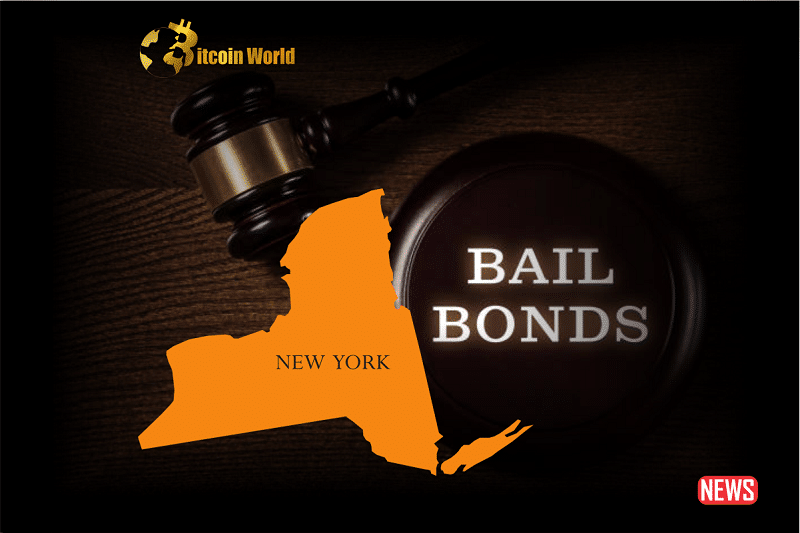Imagine a world where posting bail could involve cryptocurrency. Sounds like something out of a sci-fi movie, right? Well, in New York, this might become a reality sooner than you think. A recently introduced bill is sparking discussions about the future of stablecoins and their role within the traditional legal system. Let’s dive into the details of this groundbreaking proposal and what it could mean for the crypto landscape.
What’s the Buzz About New York Assembly Bill 7024?
On May 10th, New York took a significant step into the realm of crypto adoption with the introduction of Assembly Bill 7024. The core objective? To amend existing statutes to allow the use of stablecoins for bail bonds. Currently, the acceptable methods for bail payments in New York are cash, insurance, and credit cards. This new bill proposes adding fiat-collateralized stablecoins to that list, potentially opening up a new avenue for individuals needing to post bail.
Why Stablecoins for Bail?
While the specific stablecoins weren’t mentioned in the bill, the intention is clear: to modernize the bail bond process by incorporating digital assets. This move comes on the heels of New York Attorney General Letitia James’ own proposed crypto legislation, signaling a broader push towards regulating and integrating cryptocurrencies within the state. Could New York be setting a precedent for other states to follow?
The Broader Context: NYAG’s Crypto Regulation Push
It’s important to understand this bill within the context of New York’s evolving stance on cryptocurrency. Just days before the bail bond bill, Attorney General Letitia James unveiled her proposed “Crypto Regulation, Protection, Transparency, and Oversight (CRPTO) Act.” This comprehensive legislation aims to tighten the reins on the state’s crypto industry. Here’s a glimpse of what the CRPTO Act entails:
- Mandatory Public Audits: Cryptocurrency exchanges would be required to undergo independent public audits, enhancing transparency and accountability.
- Conflict of Interest Prevention: The act seeks to prevent conflicts of interest by prohibiting individuals from simultaneously holding ownership in related entities like brokerages and token issuers.
- Restrictions on Lending and Borrowing: The proposed regulations would make lending and borrowing crypto assets illegal within the state.
- Limitations on Exchange-Issued Tokens: The conflict of interest clause would also impact tokens issued by exchanges.
These proposed regulations paint a picture of New York aiming for stricter oversight of the crypto space. So, how does the stablecoin bail bond bill fit into this regulatory landscape?
A Step Forward or a Contradiction?
While the NYAG is advocating for tighter crypto regulations, the acceptance of stablecoins for bail bonds can be seen as a positive step towards recognizing the utility and legitimacy of these digital assets. It suggests a nuanced approach, where regulation aims to protect consumers while also fostering innovation and adoption in specific use cases.
NYAG’s Recent Crackdown: A Word of Caution
It’s crucial to remember that the New York Attorney General’s office has been actively cracking down on crypto firms. Recent legal actions against companies like Celsius, CoinEX, and KuCoin, along with involvement in the acquisition of Voyager, highlight a tough stance on non-compliant entities. This active enforcement underscores the need for crypto businesses operating in New York to adhere to stringent regulations.
The Current State of the Stablecoin Market: A Quick Snapshot
Understanding the dynamics of the stablecoin market is key to appreciating the significance of New York’s potential move. Despite some challenges, stablecoins remain a vital part of the crypto ecosystem.
Key Stablecoin Market Trends:
- The total market capitalization of stablecoins currently hovers around $131 billion, representing roughly 11% of the overall cryptocurrency market.
- Tether (USDT) dominates the market with a 62% share and $82 billion in circulation. Its supply has been steadily increasing throughout 2023.
- Circle’s USDC holds the second-largest share at 23% with $30 billion in circulation, although its market share has been declining.
- Binance USD (BUSD) has seen a decrease due to regulatory actions against its issuer, Paxos, now accounting for only 4.3% of the market with a $5.7 billion supply.
What are the Potential Benefits of Using Stablecoins for Bail?
- Increased Efficiency: Stablecoin transactions can be faster and more efficient than traditional methods.
- Wider Accessibility: It could potentially provide an alternative payment method for individuals who may not have access to traditional banking services.
- Transparency: Blockchain technology offers a transparent record of transactions.
What Challenges Might Arise?
- Volatility Concerns: Although designed to be stable, stablecoins can experience slight fluctuations in value.
- Regulatory Uncertainty: The regulatory landscape for stablecoins is still evolving.
- Technical Proficiency: Using stablecoins requires a certain level of technical understanding.
Looking Ahead: What Does This Mean for the Future?
New York’s consideration of stablecoins for bail bonds is a significant development. It signals a potential shift in how governments perceive and interact with digital assets. While challenges remain, this move could pave the way for greater integration of stablecoins into various aspects of our financial and legal systems. Keep an eye on New York – it might just be the starting point for a broader trend.
In Conclusion: A Balancing Act in the Empire State
New York’s approach to cryptocurrency is a fascinating study in contrasts. On one hand, there’s a push for stricter regulation and enforcement, aiming to protect consumers and maintain market integrity. On the other, there’s an openness to exploring the practical applications of digital assets like stablecoins, as evidenced by the proposed bail bond legislation. This balancing act highlights the complex and evolving relationship between traditional legal frameworks and the burgeoning world of cryptocurrency. Whether this bill becomes law remains to be seen, but it undoubtedly sparks an important conversation about the future of money and its intersection with the legal system.
Disclaimer: The information provided is not trading advice, Bitcoinworld.co.in holds no liability for any investments made based on the information provided on this page. We strongly recommend independent research and/or consultation with a qualified professional before making any investment decisions.


